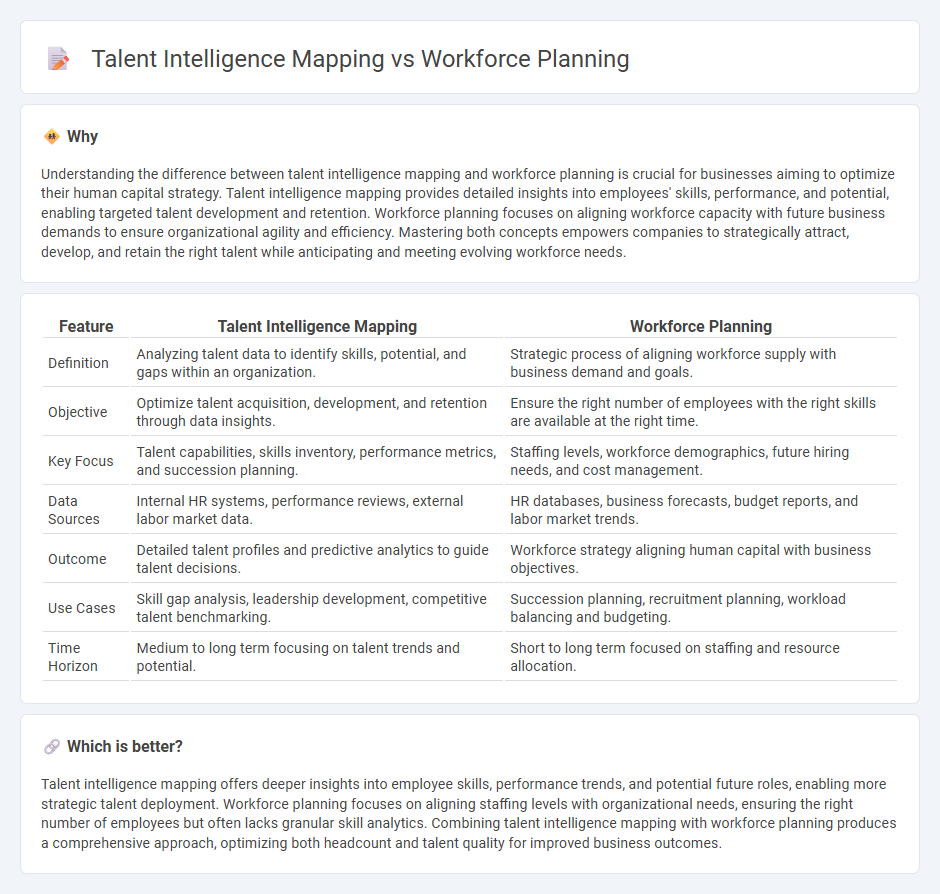
Talent intelligence mapping enhances workforce planning by providing actionable insights into skills, competencies, and talent gaps within an organization. It leverages data analytics to identify high-potential employees and forecast future talent needs, enabling more strategic decision-making. Discover how integrating talent intelligence mapping can transform your workforce planning approach.
Why it is important
Understanding the difference between talent intelligence mapping and workforce planning is crucial for businesses aiming to optimize their human capital strategy. Talent intelligence mapping provides detailed insights into employees' skills, performance, and potential, enabling targeted talent development and retention. Workforce planning focuses on aligning workforce capacity with future business demands to ensure organizational agility and efficiency. Mastering both concepts empowers companies to strategically attract, develop, and retain the right talent while anticipating and meeting evolving workforce needs.
Comparison Table
| Feature | Talent Intelligence Mapping | Workforce Planning |
|---|---|---|
| Definition | Analyzing talent data to identify skills, potential, and gaps within an organization. | Strategic process of aligning workforce supply with business demand and goals. |
| Objective | Optimize talent acquisition, development, and retention through data insights. | Ensure the right number of employees with the right skills are available at the right time. |
| Key Focus | Talent capabilities, skills inventory, performance metrics, and succession planning. | Staffing levels, workforce demographics, future hiring needs, and cost management. |
| Data Sources | Internal HR systems, performance reviews, external labor market data. | HR databases, business forecasts, budget reports, and labor market trends. |
| Outcome | Detailed talent profiles and predictive analytics to guide talent decisions. | Workforce strategy aligning human capital with business objectives. |
| Use Cases | Skill gap analysis, leadership development, competitive talent benchmarking. | Succession planning, recruitment planning, workload balancing and budgeting. |
| Time Horizon | Medium to long term focusing on talent trends and potential. | Short to long term focused on staffing and resource allocation. |
Which is better?
Talent intelligence mapping offers deeper insights into employee skills, performance trends, and potential future roles, enabling more strategic talent deployment. Workforce planning focuses on aligning staffing levels with organizational needs, ensuring the right number of employees but often lacks granular skill analytics. Combining talent intelligence mapping with workforce planning produces a comprehensive approach, optimizing both headcount and talent quality for improved business outcomes.
Connection
Talent intelligence mapping provides detailed insights into workforce capabilities and skill gaps, enabling precise workforce planning aligned with organizational goals. By analyzing data on employee competencies and market trends, companies can forecast talent needs and optimize recruitment strategies. Integrating talent intelligence with workforce planning enhances decision-making for succession, development, and efficiency in human capital management.
Key Terms
Capacity Forecasting
Workforce planning involves analyzing current employee skills and projecting future capacity needs to ensure optimal resource allocation, while talent intelligence mapping focuses on aggregating external labor market data to identify talent availability and skill trends. Capacity forecasting in workforce planning uses internal data such as headcount, turnover rates, and productivity metrics to predict workforce demands, whereas talent intelligence provides insights on competitor talent pools, salary benchmarks, and emerging skill sets. Explore detailed methodologies and tools to enhance your capacity forecasting and strategic workforce decisions.
Skills Gap Analysis
Workforce planning and talent intelligence mapping both aim to optimize organizational talent, but workforce planning focuses on forecasting future staffing needs while talent intelligence mapping centers on identifying skills gaps within the existing workforce. Skills gap analysis within talent intelligence mapping uses data-driven insights to evaluate employee competencies against business requirements, enabling targeted development and recruitment strategies. Explore detailed methodologies and best practices to enhance your skills gap analysis approach for sustained organizational growth.
Market Talent Benchmarking
Workforce planning centers on forecasting organizational talent needs to align with strategic goals, while talent intelligence mapping provides detailed insights into external market talent availability and skill trends. Market talent benchmarking evaluates competitors' workforce capabilities, compensation standards, and skill distributions, enabling data-driven recruitment and retention strategies. Explore how integrating market talent benchmarking enhances your workforce planning and talent intelligence initiatives.
Source and External Links
What Is Workforce Planning? Strategies and Benefits - Paychex - Workforce planning is the process of analyzing an organization's future staffing needs and developing strategies to meet those requirements, including assessing the current workforce, forecasting future needs, identifying gaps, and developing action plans to address them.
Workforce Planning: Definition, Process and Principles | Indeed.com - Workforce planning involves analyzing, forecasting, and planning workforce supply and demand by determining strategic direction and conducting supply and demand analyses to ensure the right skills are available to meet business objectives.
Workforce Planning - NIH: Office of Human Resources - Workforce planning is a cyclical process that includes understanding organizational strategy, current workforce status, identifying gaps, implementing talent management interventions, and monitoring results to align workforce supply with organizational goals.
 dowidth.com
dowidth.com